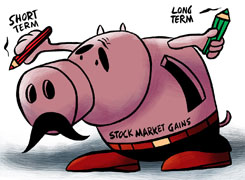Ramalingam Kalirajan |7838 Answers |Ask -Follow
Mutual Funds, Financial Planning Expert - Answered on Jun 13, 2024
He has an MBA in finance from the University of Madras and is a certified financial planner.
He is the director and chief financial planner at Holistic Investment, a Chennai-based firm that offers financial planning and wealth management advice.... more

I am unmarried women age 35 I am self employed. my earning is not fixed sometimes I earn 25k monthly or 35k or 50k monthly. How do I invest? Monthly or quarterly or annually at the end of year.
Understanding Your Financial Landscape
Before diving into investment strategies, it's important to understand your financial landscape. As a self-employed individual, your income fluctuates, making it crucial to manage your cash flow efficiently. Track your monthly expenses and income to get a clear picture of your financial situation. This will help you identify how much you can realistically set aside for investments.
Emergency Fund: Your Financial Safety Net
An emergency fund is the foundation of any sound financial plan. Aim to save at least six to twelve months' worth of expenses in a liquid and easily accessible account. This fund will provide a cushion during lean months when your income might be lower. Having an emergency fund in place will ensure you don't have to dip into your investments for unforeseen expenses.
Choosing the Right Investment Frequency
With a variable income, you might wonder whether to invest monthly, quarterly, or annually. Each approach has its merits, and the best choice depends on your cash flow and discipline.
Monthly Investments:
Monthly investments can help in averaging out the cost of investments over time. This method, known as Rupee Cost Averaging, involves investing a fixed amount regularly, irrespective of market conditions. It reduces the risk of investing a large sum at an inopportune time.
Quarterly Investments:
If your cash flow is inconsistent, quarterly investments might be a suitable middle ground. This approach allows you to accumulate funds over three months, making it easier to invest a lump sum. It also provides some flexibility to manage your finances.
Annual Investments:
Annual investments can be effective if you have a significant inflow of funds at specific times of the year. However, this approach carries the risk of market timing, where you might end up investing a large sum during market highs. To mitigate this risk, consider splitting your annual investment into two or three parts.
The Power of Goal-Based Investing
Identify your financial goals and their timelines. Common goals include building a retirement corpus, buying a house, or traveling. Assigning a timeframe and estimated cost to each goal will help you determine the investment horizon and risk tolerance for each.
Building a Diversified Portfolio
A diversified portfolio balances risk and reward by spreading investments across different asset classes. As a Certified Financial Planner, I recommend considering the following asset classes:
Equity Mutual Funds:
Equity mutual funds offer the potential for high returns over the long term. These funds invest in stocks and are suitable for goals with a horizon of five years or more. Given your fluctuating income, it's advisable to start with a Systematic Investment Plan (SIP) to benefit from Rupee Cost Averaging.
Debt Mutual Funds:
Debt mutual funds invest in fixed-income securities like bonds and treasury bills. They are less volatile than equity funds and provide steady returns. Debt funds are ideal for short to medium-term goals, helping to balance your portfolio's overall risk.
Gold:
Gold is a traditional investment that acts as a hedge against inflation and economic uncertainty. While it's not advisable to allocate a large portion of your portfolio to gold, a small percentage can provide stability. Consider investing in gold ETFs or sovereign gold bonds for better liquidity and returns.
Diversifying Internationally:
Investing a portion of your portfolio in international funds can provide exposure to global markets and reduce risk. These funds invest in equities of foreign companies, offering potential for growth and diversification.
Actively Managed Funds vs. Index Funds
There are key differences between actively managed funds and index funds. Actively managed funds involve a team of experts making investment decisions, aiming to outperform the market. They have the potential for higher returns, especially in volatile markets, due to professional management.
On the other hand, index funds passively track a market index and typically have lower fees. However, they may not offer the same level of flexibility and expertise as actively managed funds. Given the nuances of your financial situation, actively managed funds may provide a strategic advantage by leveraging expert insights to navigate market fluctuations.
The Benefits of Regular Funds Through a Certified Financial Planner
Investing through regular funds with the guidance of a Certified Financial Planner (CFP) offers significant advantages. CFPs provide personalized advice tailored to your financial goals, risk tolerance, and investment horizon. They help you navigate complex market conditions and make informed decisions.
Regular funds involve a small fee paid to the mutual fund distributor (MFD), who can assist with portfolio reviews, rebalancing, and goal tracking. This professional support can be invaluable, ensuring your investments align with your financial objectives and adapt to changing market conditions.
Balancing Insurance and Investment
It's crucial to separate your insurance and investment needs. While insurance products with investment components, like ULIPs and endowment policies, might seem attractive, they often come with high charges and lower returns. Pure insurance policies, such as term insurance, provide adequate coverage at a lower cost.
If you currently hold LIC, ULIP, or investment-cum-insurance policies, consider surrendering them and reinvesting the proceeds in mutual funds. This can potentially enhance your returns and provide better liquidity.
Tax Planning and Investments
Effective tax planning can significantly impact your overall returns. Utilize tax-saving instruments under Section 80C, such as Equity Linked Savings Schemes (ELSS), Public Provident Fund (PPF), and National Savings Certificate (NSC). ELSS funds, in particular, offer the dual benefit of tax savings and potential for high returns due to their equity exposure.
Automating Your Investments
Automating your investments can simplify the process and ensure consistency. Set up automated transfers to your investment accounts, aligning with your chosen investment frequency. This approach reduces the temptation to time the market and ensures you stay on track with your financial goals.
Reviewing and Rebalancing Your Portfolio
Regularly review your portfolio to ensure it aligns with your goals and risk tolerance. Life events, market conditions, and changes in income can impact your financial situation. Rebalancing your portfolio periodically helps maintain the desired asset allocation and manage risk.
Understanding Investment Risks
All investments come with inherent risks, and it's essential to understand these before making decisions. Equity investments can be volatile in the short term but tend to provide higher returns over the long term. Debt investments offer more stability but usually yield lower returns compared to equities.
Assess your risk tolerance honestly. Given your variable income, a balanced approach that includes both equity and debt investments can provide growth potential while managing risk.
Leveraging Professional Guidance
Engaging a Certified Financial Planner can provide invaluable insights and strategies tailored to your specific needs. A CFP can help you create a comprehensive financial plan, monitor your progress, and adjust strategies as needed. This professional guidance can be especially beneficial given your variable income and the complexities of investment options.
Empathy and Understanding Your Journey
We understand the unique challenges faced by self-employed individuals with fluctuating incomes. It's commendable that you are taking proactive steps towards securing your financial future. Your commitment to understanding and improving your financial situation is a crucial first step.
Genuine Compliments and Encouragement
Your decision to seek guidance and plan your investments is praiseworthy. It demonstrates foresight and a strong commitment to financial well-being. By leveraging these insights and strategies, you are setting yourself on a path to achieving your financial goals.
Final Insights
Investing effectively with a variable income requires a strategic and disciplined approach. Start by understanding your financial landscape, building an emergency fund, and choosing the right investment frequency. Goal-based investing and a diversified portfolio can help balance risk and reward.
Actively managed funds, with professional guidance from a Certified Financial Planner, offer strategic advantages over index and direct funds. Separating insurance and investment needs, effective tax planning, and automating investments can enhance your financial strategy. Regular reviews and rebalancing ensure your portfolio stays aligned with your goals.
Your proactive approach to financial planning is commendable. By implementing these strategies, you can navigate the challenges of a variable income and build a secure financial future.
Best Regards,
K. Ramalingam, MBA, CFP,
Chief Financial Planner,
www.holisticinvestment.in
You may like to see similar questions and answers below
Ramalingam Kalirajan |7838 Answers |Ask -Follow
Mutual Funds, Financial Planning Expert - Answered on Jul 02, 2024
Ramalingam Kalirajan |7838 Answers |Ask -Follow
Mutual Funds, Financial Planning Expert - Answered on Jun 23, 2024
Ramalingam Kalirajan |7838 Answers |Ask -Follow
Mutual Funds, Financial Planning Expert - Answered on Jun 30, 2024
Ramalingam Kalirajan |7838 Answers |Ask -Follow
Mutual Funds, Financial Planning Expert - Answered on Jul 04, 2024
Mayank Chandel |1994 Answers |Ask -Follow
IIT-JEE, NEET-UG, SAT, CLAT, CA, CS Exam Expert - Answered on Feb 05, 2025
Mayank Chandel |1994 Answers |Ask -Follow
IIT-JEE, NEET-UG, SAT, CLAT, CA, CS Exam Expert - Answered on Feb 05, 2025
Mayank Chandel |1994 Answers |Ask -Follow
IIT-JEE, NEET-UG, SAT, CLAT, CA, CS Exam Expert - Answered on Feb 05, 2025
Milind Vadjikar |977 Answers |Ask -Follow
Insurance, Stocks, MF, PF Expert - Answered on Feb 05, 2025
Mayank Chandel |1994 Answers |Ask -Follow
IIT-JEE, NEET-UG, SAT, CLAT, CA, CS Exam Expert - Answered on Feb 05, 2025
Mayank Chandel |1994 Answers |Ask -Follow
IIT-JEE, NEET-UG, SAT, CLAT, CA, CS Exam Expert - Answered on Feb 05, 2025
Milind Vadjikar |977 Answers |Ask -Follow
Insurance, Stocks, MF, PF Expert - Answered on Feb 05, 2025
Milind Vadjikar |977 Answers |Ask -Follow
Insurance, Stocks, MF, PF Expert - Answered on Feb 05, 2025
Ravi Mittal |520 Answers |Ask -Follow
Dating, Relationships Expert - Answered on Feb 05, 2025
Ramalingam Kalirajan |7838 Answers |Ask -Follow
Mutual Funds, Financial Planning Expert - Answered on Feb 05, 2025



















